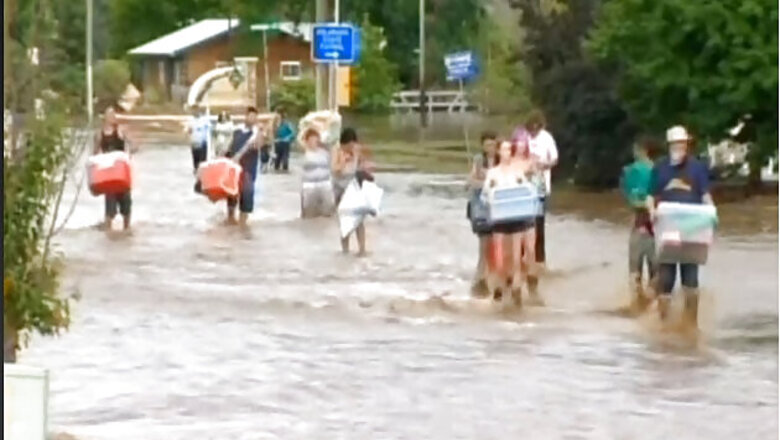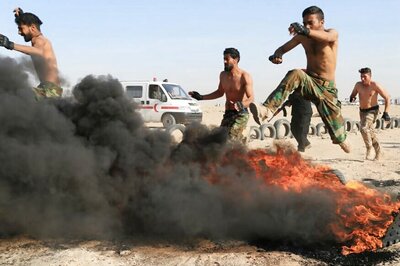
views
Search-and-rescue teams bolstered by National Guard troops fanned out across Colorado's flood-stricken landscape on Monday, as a week of torrential rains blamed for eight deaths and the destruction of at least 1,600 homes finally gave way to sunny skies.
Much of the evacuation effort was focused on remote foothill and canyon communities in north-central Colorado, where the bulk of nearly 12,000 people evacuated since last week were stranded due to washed-out roads, bridges and communication lines, state emergency officials said.
The overall flood zone has encompassed 17 Colorado counties across a normally semi-arid region nearly the size of Delaware.
Drizzle and patchy morning fog that had hampered airborne emergency operations early on Monday lifted by afternoon, allowing National Guard helicopters to return to the skies to help ground teams find trapped flood victims and carry them to safety.
In Boulder County alone, about 1,500 people had been evacuated to emergency shelters as of Sunday night and another 160 on Monday, most of them by helicopter, county emergency management office spokeswoman Liz Donaghey said.
The rest were ferried out by military vehicles. Many of the air-lifted evacuees had to be hoisted by hovering choppers one at a time from rooftops and upper-floor balconies, she said.
Asked how many more may still be stranded, she said, "We don't know what we've got until we have them."
In neighbouring Larimer County, officials put the number of evacuees yet to be reached at roughly 1,000.
RATTLESNAKES AND RAILROADS
Meanwhile, ranchers have been advised to move livestock away from rain-swollen streams as floodwaters spread further east onto the prairie, and authorities warned residents to be on the lookout for rattlesnakes that might be slithering to higher ground.
Larimer and Boulder counties bore the brunt of flash floods first unleashed last week by heavy rains that started last Monday and drenched Colorado's biggest urban centers along a 130-mile (210-km) stretch in the Front Range of the Rockies.
At the peak of the disaster - the heaviest deluge to hit the region in four decades, experts said - floodwaters roared down rain-saturated mountainsides northwest of Denver and spilled through canyons funneling the runoff into populated areas below.
The flooding progressed downstream and spread onto the prairie through the weekend. The rain-gorged South Platte River continued to top its banks on Monday, submerging large tracts of farmland as flooding rolled eastward in the direction of Nebraska.
Authorities said downstream flooding could be worsened by a river channel cluttered with overgrown vegetation and debris from several years of minimal flows along the South Platte.
State officials issued flood warnings to Nebraska residents urging them to shut off utilities and electrical machinery along the river.
DEATH TOLL AT EIGHT
In its latest update on the disaster, the Colorado Office of Emergency Management said the official death toll had risen to eight, up from five over the weekend.
The latest count included two women, aged 60 and 80, who were reported missing and presumed dead since Sunday, after their homes were washed away by floodwaters in the Big Thompson Canyon area of Larimer County.
As of midday Monday, nearly 600 people remained unaccounted for in Larimer and Boulder counties combined, with many believed to be still stranded in remote areas cut off by floodwaters and left without telephone, cell phone or Internet service, officials said.
An estimated 1,500 homes have been destroyed and 4,500 damaged in Larimer County alone, emergency management spokeswoman Jennifer Hillmann said. In addition, 200 businesses have been lost and 500 damaged, she said, citing preliminary assessments by the county.
Boulder County officials confirmed 108 homes were destroyed in the hard-hit town of Lyons but had no countywide property loss figures.
Air rescue operations were the largest in the United States since flooding in the aftermath of Hurricane Katrina devastated New Orleans in 2005, National Guard officials said.
President Barack Obama declared the area a major disaster over the weekend, freeing up federal funds and resources to aid state and local governments.
State officials would be unable to assess the overall damage until rescue efforts were complete and the floodwaters had receded, said Micki Trost, a spokeswoman for the state Office of Emergency Management.
The prolonged showers were caused by an atmospheric low-pressure system that stalled over Nevada and western Utah, drawing extremely moist air out of Mexico and streaming it north into the southern Rockies, meteorologists said.
Kyle Fredin, a meteorologist for the National Weather Service, said 21 inches of rain fell in parts of Boulder city, northwest of Denver, during the week-long deluge, nearly double the area's average annual rainfall.
The last multi-day rainfall to spawn widespread flooding in Colorado's Front Range occurred in 1969. But a single-night downpour from a 1976 thunderstorm triggered a flash flood that killed more than 140 people in Big Thompson Canyon.

















Comments
0 comment